SCBCH2002 - Understanding Insulinoma: Signs, Symptoms, Treatment
VerifiedAdded on 2023/06/03
|11
|3053
|441
Report
AI Summary
This report provides a detailed overview of insulinoma, a rare pancreatic tumor that causes excessive insulin production, leading to hypoglycemia. It discusses the signs and symptoms of insulinoma, ranging from mild issues like tremors and weight gain to severe complications such as seizures and loss of consciousness. The report outlines diagnostic procedures, including blood tests and imaging techniques like CT scans and MRIs, to confirm the presence and location of the tumor. Furthermore, it explores various treatment options, including surgical interventions such as enucleation, laparoscopic surgery, and open surgery (including pancreatectomy), as well as treatments for cancerous insulinoma like radiofrequency ablation, chemotherapy, and dietary management to control blood sugar levels. The report also touches on rare family syndromes that may contribute to the development of insulinoma.

Insulinoma 1
Signs, Symptoms, and Treatment of Insulinoma
Author
Course:
Tutor:
Institution:
Date:
Signs, Symptoms, and Treatment of Insulinoma
Author
Course:
Tutor:
Institution:
Date:
Paraphrase This Document
Need a fresh take? Get an instant paraphrase of this document with our AI Paraphraser
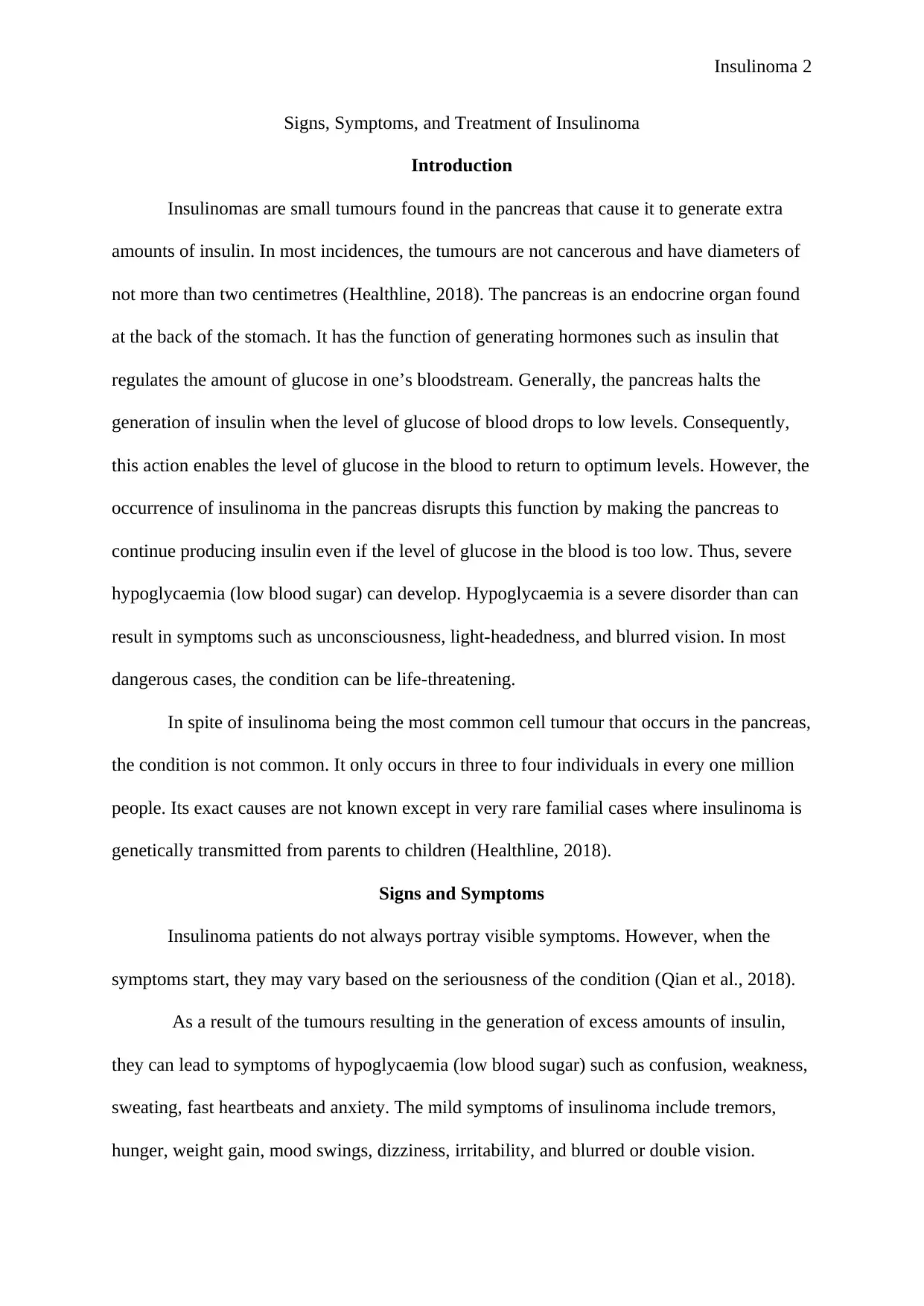
Insulinoma 2
Signs, Symptoms, and Treatment of Insulinoma
Introduction
Insulinomas are small tumours found in the pancreas that cause it to generate extra
amounts of insulin. In most incidences, the tumours are not cancerous and have diameters of
not more than two centimetres (Healthline, 2018). The pancreas is an endocrine organ found
at the back of the stomach. It has the function of generating hormones such as insulin that
regulates the amount of glucose in one’s bloodstream. Generally, the pancreas halts the
generation of insulin when the level of glucose of blood drops to low levels. Consequently,
this action enables the level of glucose in the blood to return to optimum levels. However, the
occurrence of insulinoma in the pancreas disrupts this function by making the pancreas to
continue producing insulin even if the level of glucose in the blood is too low. Thus, severe
hypoglycaemia (low blood sugar) can develop. Hypoglycaemia is a severe disorder than can
result in symptoms such as unconsciousness, light-headedness, and blurred vision. In most
dangerous cases, the condition can be life-threatening.
In spite of insulinoma being the most common cell tumour that occurs in the pancreas,
the condition is not common. It only occurs in three to four individuals in every one million
people. Its exact causes are not known except in very rare familial cases where insulinoma is
genetically transmitted from parents to children (Healthline, 2018).
Signs and Symptoms
Insulinoma patients do not always portray visible symptoms. However, when the
symptoms start, they may vary based on the seriousness of the condition (Qian et al., 2018).
As a result of the tumours resulting in the generation of excess amounts of insulin,
they can lead to symptoms of hypoglycaemia (low blood sugar) such as confusion, weakness,
sweating, fast heartbeats and anxiety. The mild symptoms of insulinoma include tremors,
hunger, weight gain, mood swings, dizziness, irritability, and blurred or double vision.
Signs, Symptoms, and Treatment of Insulinoma
Introduction
Insulinomas are small tumours found in the pancreas that cause it to generate extra
amounts of insulin. In most incidences, the tumours are not cancerous and have diameters of
not more than two centimetres (Healthline, 2018). The pancreas is an endocrine organ found
at the back of the stomach. It has the function of generating hormones such as insulin that
regulates the amount of glucose in one’s bloodstream. Generally, the pancreas halts the
generation of insulin when the level of glucose of blood drops to low levels. Consequently,
this action enables the level of glucose in the blood to return to optimum levels. However, the
occurrence of insulinoma in the pancreas disrupts this function by making the pancreas to
continue producing insulin even if the level of glucose in the blood is too low. Thus, severe
hypoglycaemia (low blood sugar) can develop. Hypoglycaemia is a severe disorder than can
result in symptoms such as unconsciousness, light-headedness, and blurred vision. In most
dangerous cases, the condition can be life-threatening.
In spite of insulinoma being the most common cell tumour that occurs in the pancreas,
the condition is not common. It only occurs in three to four individuals in every one million
people. Its exact causes are not known except in very rare familial cases where insulinoma is
genetically transmitted from parents to children (Healthline, 2018).
Signs and Symptoms
Insulinoma patients do not always portray visible symptoms. However, when the
symptoms start, they may vary based on the seriousness of the condition (Qian et al., 2018).
As a result of the tumours resulting in the generation of excess amounts of insulin,
they can lead to symptoms of hypoglycaemia (low blood sugar) such as confusion, weakness,
sweating, fast heartbeats and anxiety. The mild symptoms of insulinoma include tremors,
hunger, weight gain, mood swings, dizziness, irritability, and blurred or double vision.
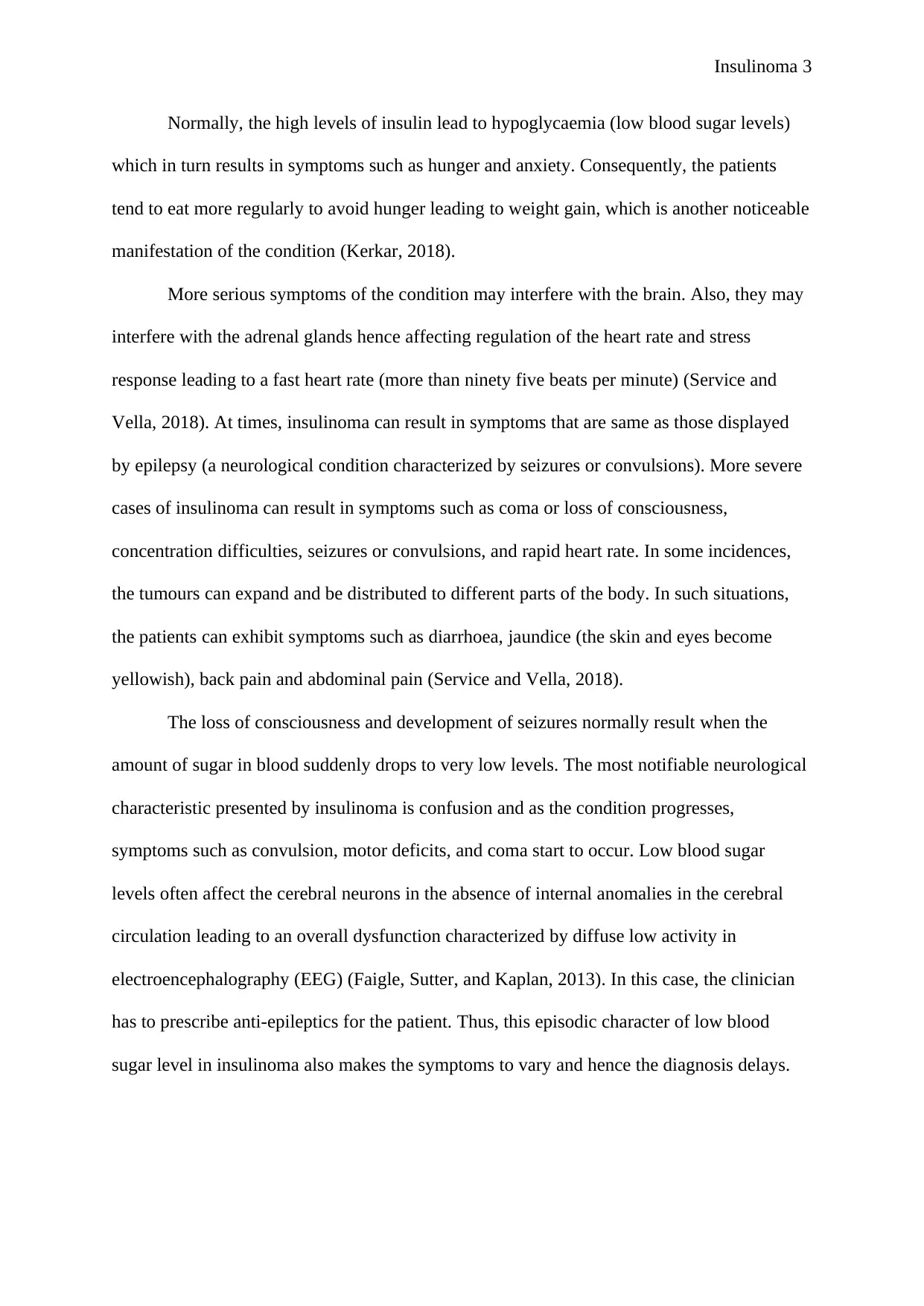
Insulinoma 3
Normally, the high levels of insulin lead to hypoglycaemia (low blood sugar levels)
which in turn results in symptoms such as hunger and anxiety. Consequently, the patients
tend to eat more regularly to avoid hunger leading to weight gain, which is another noticeable
manifestation of the condition (Kerkar, 2018).
More serious symptoms of the condition may interfere with the brain. Also, they may
interfere with the adrenal glands hence affecting regulation of the heart rate and stress
response leading to a fast heart rate (more than ninety five beats per minute) (Service and
Vella, 2018). At times, insulinoma can result in symptoms that are same as those displayed
by epilepsy (a neurological condition characterized by seizures or convulsions). More severe
cases of insulinoma can result in symptoms such as coma or loss of consciousness,
concentration difficulties, seizures or convulsions, and rapid heart rate. In some incidences,
the tumours can expand and be distributed to different parts of the body. In such situations,
the patients can exhibit symptoms such as diarrhoea, jaundice (the skin and eyes become
yellowish), back pain and abdominal pain (Service and Vella, 2018).
The loss of consciousness and development of seizures normally result when the
amount of sugar in blood suddenly drops to very low levels. The most notifiable neurological
characteristic presented by insulinoma is confusion and as the condition progresses,
symptoms such as convulsion, motor deficits, and coma start to occur. Low blood sugar
levels often affect the cerebral neurons in the absence of internal anomalies in the cerebral
circulation leading to an overall dysfunction characterized by diffuse low activity in
electroencephalography (EEG) (Faigle, Sutter, and Kaplan, 2013). In this case, the clinician
has to prescribe anti-epileptics for the patient. Thus, this episodic character of low blood
sugar level in insulinoma also makes the symptoms to vary and hence the diagnosis delays.
Normally, the high levels of insulin lead to hypoglycaemia (low blood sugar levels)
which in turn results in symptoms such as hunger and anxiety. Consequently, the patients
tend to eat more regularly to avoid hunger leading to weight gain, which is another noticeable
manifestation of the condition (Kerkar, 2018).
More serious symptoms of the condition may interfere with the brain. Also, they may
interfere with the adrenal glands hence affecting regulation of the heart rate and stress
response leading to a fast heart rate (more than ninety five beats per minute) (Service and
Vella, 2018). At times, insulinoma can result in symptoms that are same as those displayed
by epilepsy (a neurological condition characterized by seizures or convulsions). More severe
cases of insulinoma can result in symptoms such as coma or loss of consciousness,
concentration difficulties, seizures or convulsions, and rapid heart rate. In some incidences,
the tumours can expand and be distributed to different parts of the body. In such situations,
the patients can exhibit symptoms such as diarrhoea, jaundice (the skin and eyes become
yellowish), back pain and abdominal pain (Service and Vella, 2018).
The loss of consciousness and development of seizures normally result when the
amount of sugar in blood suddenly drops to very low levels. The most notifiable neurological
characteristic presented by insulinoma is confusion and as the condition progresses,
symptoms such as convulsion, motor deficits, and coma start to occur. Low blood sugar
levels often affect the cerebral neurons in the absence of internal anomalies in the cerebral
circulation leading to an overall dysfunction characterized by diffuse low activity in
electroencephalography (EEG) (Faigle, Sutter, and Kaplan, 2013). In this case, the clinician
has to prescribe anti-epileptics for the patient. Thus, this episodic character of low blood
sugar level in insulinoma also makes the symptoms to vary and hence the diagnosis delays.
You're viewing a preview
Unlock full access by subscribing today!
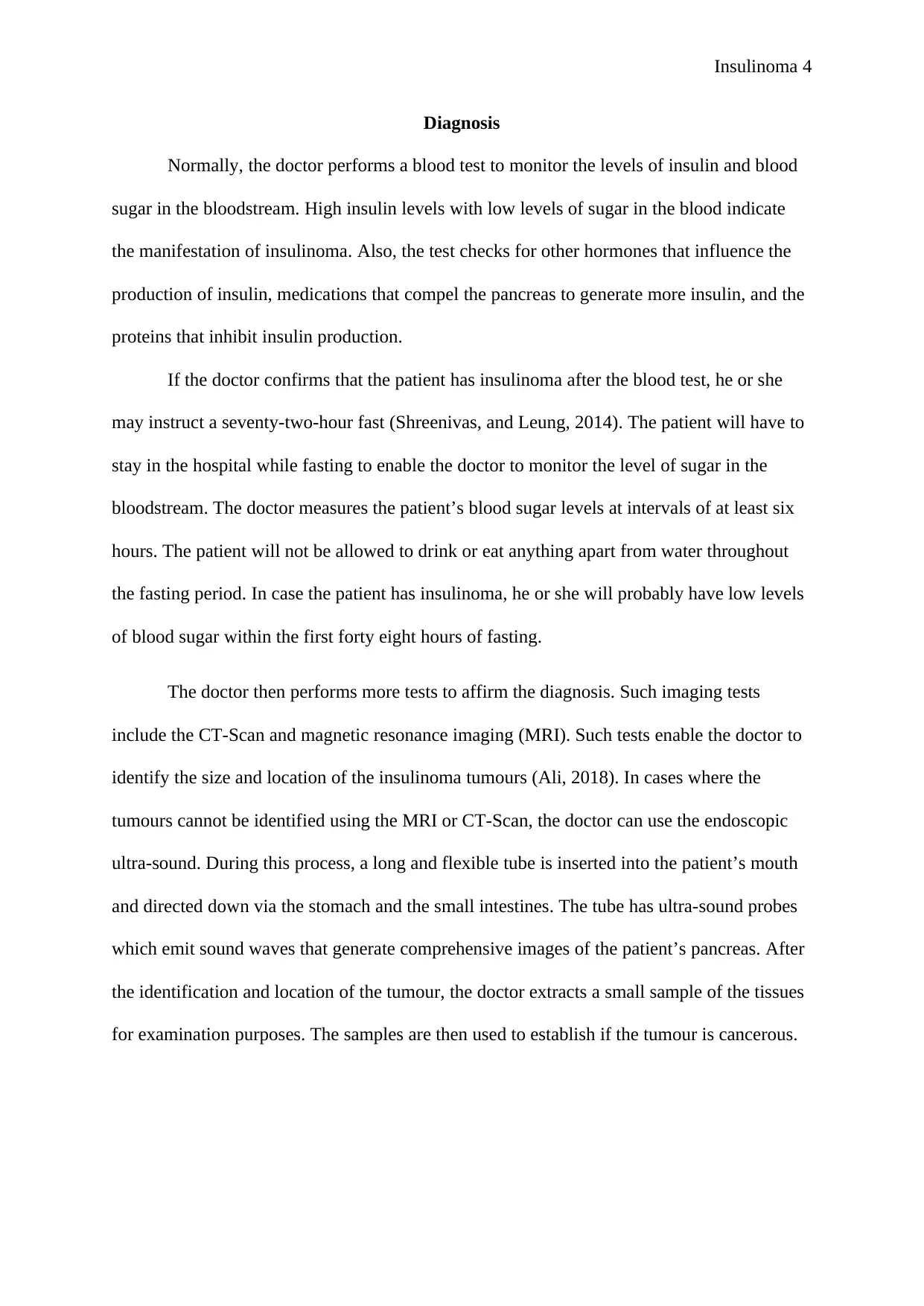
Insulinoma 4
Diagnosis
Normally, the doctor performs a blood test to monitor the levels of insulin and blood
sugar in the bloodstream. High insulin levels with low levels of sugar in the blood indicate
the manifestation of insulinoma. Also, the test checks for other hormones that influence the
production of insulin, medications that compel the pancreas to generate more insulin, and the
proteins that inhibit insulin production.
If the doctor confirms that the patient has insulinoma after the blood test, he or she
may instruct a seventy-two-hour fast (Shreenivas, and Leung, 2014). The patient will have to
stay in the hospital while fasting to enable the doctor to monitor the level of sugar in the
bloodstream. The doctor measures the patient’s blood sugar levels at intervals of at least six
hours. The patient will not be allowed to drink or eat anything apart from water throughout
the fasting period. In case the patient has insulinoma, he or she will probably have low levels
of blood sugar within the first forty eight hours of fasting.
The doctor then performs more tests to affirm the diagnosis. Such imaging tests
include the CT-Scan and magnetic resonance imaging (MRI). Such tests enable the doctor to
identify the size and location of the insulinoma tumours (Ali, 2018). In cases where the
tumours cannot be identified using the MRI or CT-Scan, the doctor can use the endoscopic
ultra-sound. During this process, a long and flexible tube is inserted into the patient’s mouth
and directed down via the stomach and the small intestines. The tube has ultra-sound probes
which emit sound waves that generate comprehensive images of the patient’s pancreas. After
the identification and location of the tumour, the doctor extracts a small sample of the tissues
for examination purposes. The samples are then used to establish if the tumour is cancerous.
Diagnosis
Normally, the doctor performs a blood test to monitor the levels of insulin and blood
sugar in the bloodstream. High insulin levels with low levels of sugar in the blood indicate
the manifestation of insulinoma. Also, the test checks for other hormones that influence the
production of insulin, medications that compel the pancreas to generate more insulin, and the
proteins that inhibit insulin production.
If the doctor confirms that the patient has insulinoma after the blood test, he or she
may instruct a seventy-two-hour fast (Shreenivas, and Leung, 2014). The patient will have to
stay in the hospital while fasting to enable the doctor to monitor the level of sugar in the
bloodstream. The doctor measures the patient’s blood sugar levels at intervals of at least six
hours. The patient will not be allowed to drink or eat anything apart from water throughout
the fasting period. In case the patient has insulinoma, he or she will probably have low levels
of blood sugar within the first forty eight hours of fasting.
The doctor then performs more tests to affirm the diagnosis. Such imaging tests
include the CT-Scan and magnetic resonance imaging (MRI). Such tests enable the doctor to
identify the size and location of the insulinoma tumours (Ali, 2018). In cases where the
tumours cannot be identified using the MRI or CT-Scan, the doctor can use the endoscopic
ultra-sound. During this process, a long and flexible tube is inserted into the patient’s mouth
and directed down via the stomach and the small intestines. The tube has ultra-sound probes
which emit sound waves that generate comprehensive images of the patient’s pancreas. After
the identification and location of the tumour, the doctor extracts a small sample of the tissues
for examination purposes. The samples are then used to establish if the tumour is cancerous.
Paraphrase This Document
Need a fresh take? Get an instant paraphrase of this document with our AI Paraphraser
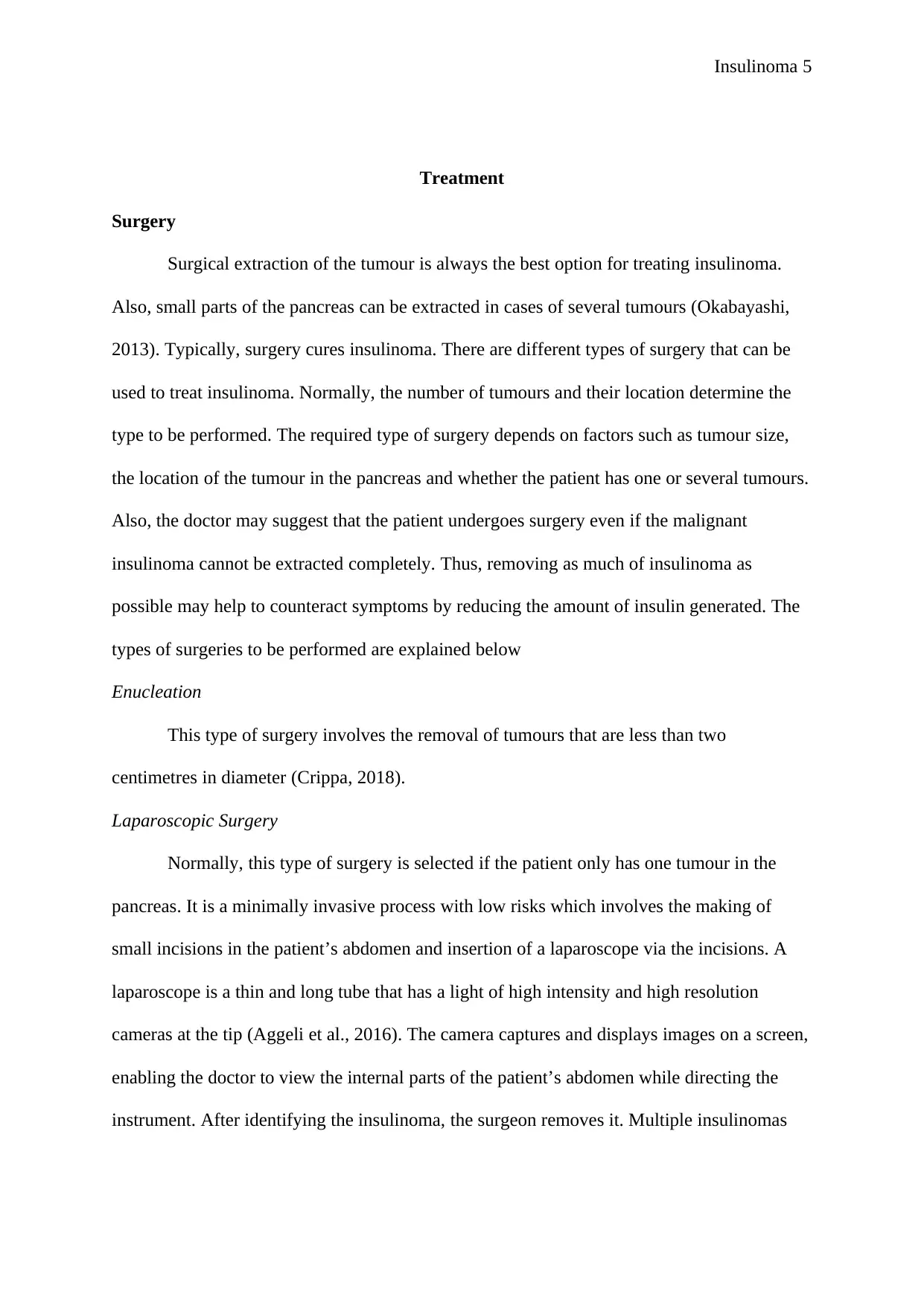
Insulinoma 5
Treatment
Surgery
Surgical extraction of the tumour is always the best option for treating insulinoma.
Also, small parts of the pancreas can be extracted in cases of several tumours (Okabayashi,
2013). Typically, surgery cures insulinoma. There are different types of surgery that can be
used to treat insulinoma. Normally, the number of tumours and their location determine the
type to be performed. The required type of surgery depends on factors such as tumour size,
the location of the tumour in the pancreas and whether the patient has one or several tumours.
Also, the doctor may suggest that the patient undergoes surgery even if the malignant
insulinoma cannot be extracted completely. Thus, removing as much of insulinoma as
possible may help to counteract symptoms by reducing the amount of insulin generated. The
types of surgeries to be performed are explained below
Enucleation
This type of surgery involves the removal of tumours that are less than two
centimetres in diameter (Crippa, 2018).
Laparoscopic Surgery
Normally, this type of surgery is selected if the patient only has one tumour in the
pancreas. It is a minimally invasive process with low risks which involves the making of
small incisions in the patient’s abdomen and insertion of a laparoscope via the incisions. A
laparoscope is a thin and long tube that has a light of high intensity and high resolution
cameras at the tip (Aggeli et al., 2016). The camera captures and displays images on a screen,
enabling the doctor to view the internal parts of the patient’s abdomen while directing the
instrument. After identifying the insulinoma, the surgeon removes it. Multiple insulinomas
Treatment
Surgery
Surgical extraction of the tumour is always the best option for treating insulinoma.
Also, small parts of the pancreas can be extracted in cases of several tumours (Okabayashi,
2013). Typically, surgery cures insulinoma. There are different types of surgery that can be
used to treat insulinoma. Normally, the number of tumours and their location determine the
type to be performed. The required type of surgery depends on factors such as tumour size,
the location of the tumour in the pancreas and whether the patient has one or several tumours.
Also, the doctor may suggest that the patient undergoes surgery even if the malignant
insulinoma cannot be extracted completely. Thus, removing as much of insulinoma as
possible may help to counteract symptoms by reducing the amount of insulin generated. The
types of surgeries to be performed are explained below
Enucleation
This type of surgery involves the removal of tumours that are less than two
centimetres in diameter (Crippa, 2018).
Laparoscopic Surgery
Normally, this type of surgery is selected if the patient only has one tumour in the
pancreas. It is a minimally invasive process with low risks which involves the making of
small incisions in the patient’s abdomen and insertion of a laparoscope via the incisions. A
laparoscope is a thin and long tube that has a light of high intensity and high resolution
cameras at the tip (Aggeli et al., 2016). The camera captures and displays images on a screen,
enabling the doctor to view the internal parts of the patient’s abdomen while directing the
instrument. After identifying the insulinoma, the surgeon removes it. Multiple insulinomas
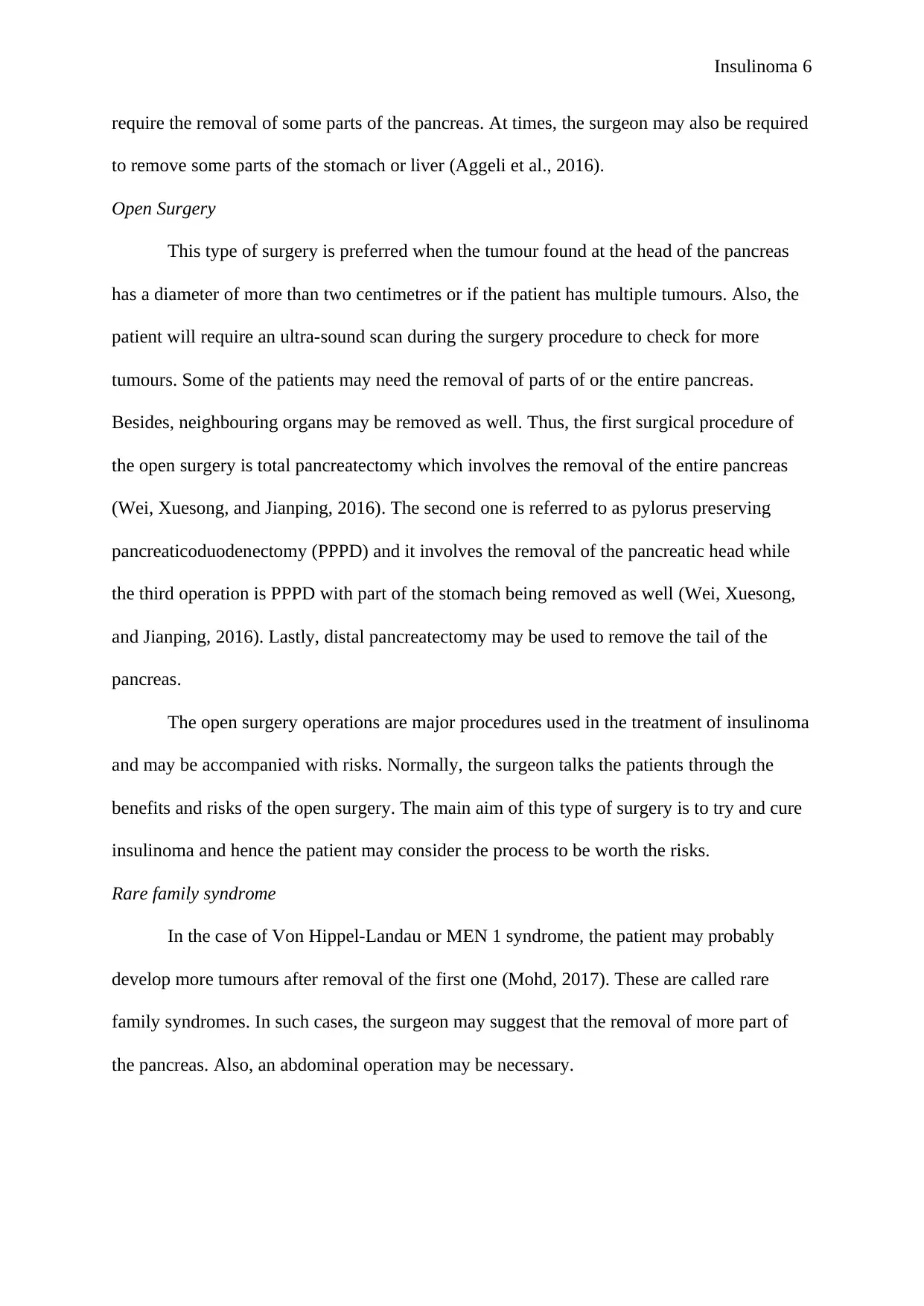
Insulinoma 6
require the removal of some parts of the pancreas. At times, the surgeon may also be required
to remove some parts of the stomach or liver (Aggeli et al., 2016).
Open Surgery
This type of surgery is preferred when the tumour found at the head of the pancreas
has a diameter of more than two centimetres or if the patient has multiple tumours. Also, the
patient will require an ultra-sound scan during the surgery procedure to check for more
tumours. Some of the patients may need the removal of parts of or the entire pancreas.
Besides, neighbouring organs may be removed as well. Thus, the first surgical procedure of
the open surgery is total pancreatectomy which involves the removal of the entire pancreas
(Wei, Xuesong, and Jianping, 2016). The second one is referred to as pylorus preserving
pancreaticoduodenectomy (PPPD) and it involves the removal of the pancreatic head while
the third operation is PPPD with part of the stomach being removed as well (Wei, Xuesong,
and Jianping, 2016). Lastly, distal pancreatectomy may be used to remove the tail of the
pancreas.
The open surgery operations are major procedures used in the treatment of insulinoma
and may be accompanied with risks. Normally, the surgeon talks the patients through the
benefits and risks of the open surgery. The main aim of this type of surgery is to try and cure
insulinoma and hence the patient may consider the process to be worth the risks.
Rare family syndrome
In the case of Von Hippel-Landau or MEN 1 syndrome, the patient may probably
develop more tumours after removal of the first one (Mohd, 2017). These are called rare
family syndromes. In such cases, the surgeon may suggest that the removal of more part of
the pancreas. Also, an abdominal operation may be necessary.
require the removal of some parts of the pancreas. At times, the surgeon may also be required
to remove some parts of the stomach or liver (Aggeli et al., 2016).
Open Surgery
This type of surgery is preferred when the tumour found at the head of the pancreas
has a diameter of more than two centimetres or if the patient has multiple tumours. Also, the
patient will require an ultra-sound scan during the surgery procedure to check for more
tumours. Some of the patients may need the removal of parts of or the entire pancreas.
Besides, neighbouring organs may be removed as well. Thus, the first surgical procedure of
the open surgery is total pancreatectomy which involves the removal of the entire pancreas
(Wei, Xuesong, and Jianping, 2016). The second one is referred to as pylorus preserving
pancreaticoduodenectomy (PPPD) and it involves the removal of the pancreatic head while
the third operation is PPPD with part of the stomach being removed as well (Wei, Xuesong,
and Jianping, 2016). Lastly, distal pancreatectomy may be used to remove the tail of the
pancreas.
The open surgery operations are major procedures used in the treatment of insulinoma
and may be accompanied with risks. Normally, the surgeon talks the patients through the
benefits and risks of the open surgery. The main aim of this type of surgery is to try and cure
insulinoma and hence the patient may consider the process to be worth the risks.
Rare family syndrome
In the case of Von Hippel-Landau or MEN 1 syndrome, the patient may probably
develop more tumours after removal of the first one (Mohd, 2017). These are called rare
family syndromes. In such cases, the surgeon may suggest that the removal of more part of
the pancreas. Also, an abdominal operation may be necessary.
You're viewing a preview
Unlock full access by subscribing today!
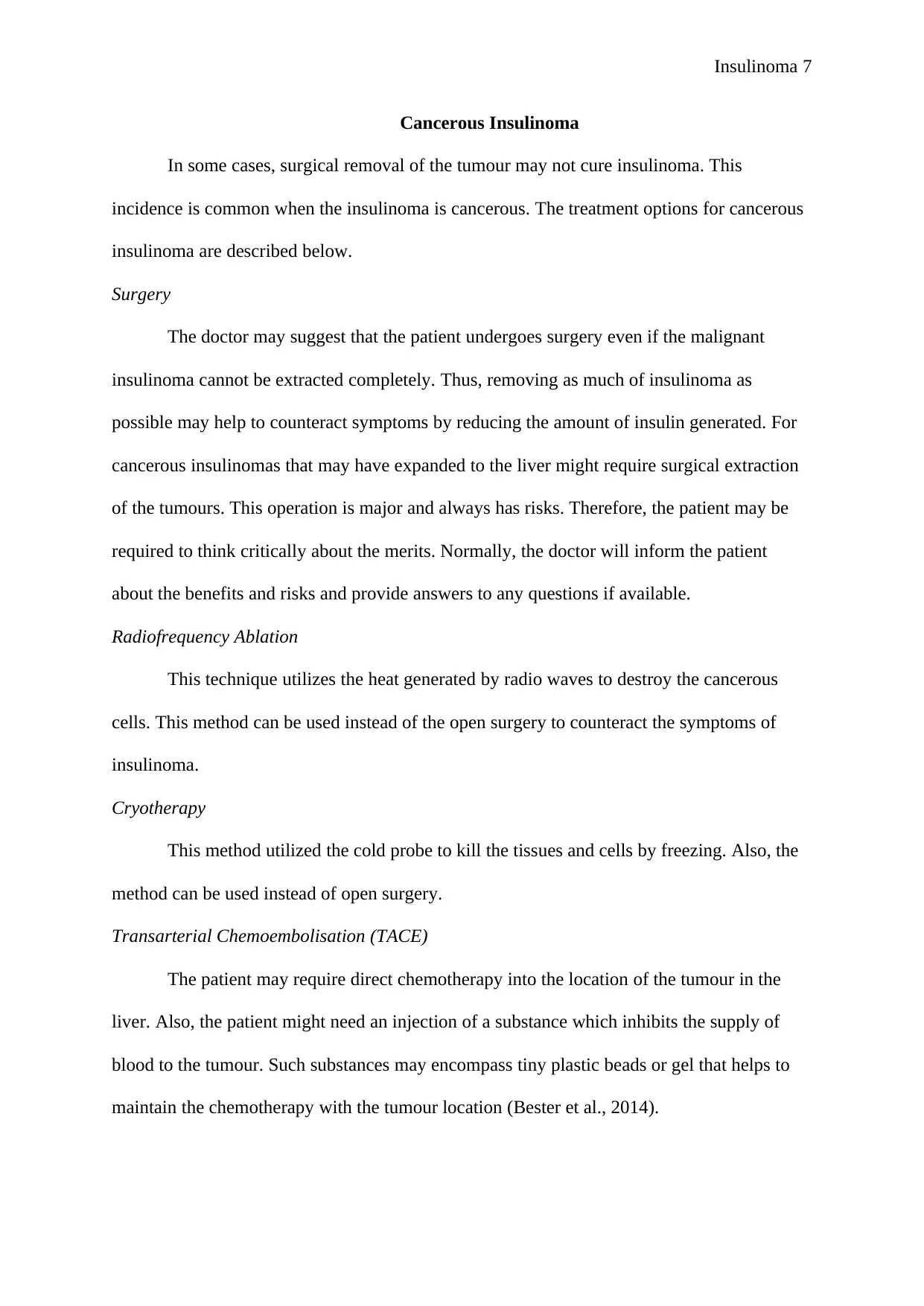
Insulinoma 7
Cancerous Insulinoma
In some cases, surgical removal of the tumour may not cure insulinoma. This
incidence is common when the insulinoma is cancerous. The treatment options for cancerous
insulinoma are described below.
Surgery
The doctor may suggest that the patient undergoes surgery even if the malignant
insulinoma cannot be extracted completely. Thus, removing as much of insulinoma as
possible may help to counteract symptoms by reducing the amount of insulin generated. For
cancerous insulinomas that may have expanded to the liver might require surgical extraction
of the tumours. This operation is major and always has risks. Therefore, the patient may be
required to think critically about the merits. Normally, the doctor will inform the patient
about the benefits and risks and provide answers to any questions if available.
Radiofrequency Ablation
This technique utilizes the heat generated by radio waves to destroy the cancerous
cells. This method can be used instead of the open surgery to counteract the symptoms of
insulinoma.
Cryotherapy
This method utilized the cold probe to kill the tissues and cells by freezing. Also, the
method can be used instead of open surgery.
Transarterial Chemoembolisation (TACE)
The patient may require direct chemotherapy into the location of the tumour in the
liver. Also, the patient might need an injection of a substance which inhibits the supply of
blood to the tumour. Such substances may encompass tiny plastic beads or gel that helps to
maintain the chemotherapy with the tumour location (Bester et al., 2014).
Cancerous Insulinoma
In some cases, surgical removal of the tumour may not cure insulinoma. This
incidence is common when the insulinoma is cancerous. The treatment options for cancerous
insulinoma are described below.
Surgery
The doctor may suggest that the patient undergoes surgery even if the malignant
insulinoma cannot be extracted completely. Thus, removing as much of insulinoma as
possible may help to counteract symptoms by reducing the amount of insulin generated. For
cancerous insulinomas that may have expanded to the liver might require surgical extraction
of the tumours. This operation is major and always has risks. Therefore, the patient may be
required to think critically about the merits. Normally, the doctor will inform the patient
about the benefits and risks and provide answers to any questions if available.
Radiofrequency Ablation
This technique utilizes the heat generated by radio waves to destroy the cancerous
cells. This method can be used instead of the open surgery to counteract the symptoms of
insulinoma.
Cryotherapy
This method utilized the cold probe to kill the tissues and cells by freezing. Also, the
method can be used instead of open surgery.
Transarterial Chemoembolisation (TACE)
The patient may require direct chemotherapy into the location of the tumour in the
liver. Also, the patient might need an injection of a substance which inhibits the supply of
blood to the tumour. Such substances may encompass tiny plastic beads or gel that helps to
maintain the chemotherapy with the tumour location (Bester et al., 2014).
Paraphrase This Document
Need a fresh take? Get an instant paraphrase of this document with our AI Paraphraser

Insulinoma 8
Selective Internal Radiotherapy (SIRT)
This process involves the injection of microscopic beads covered with radioactive
substances referred to as Yttrium-90 into the bloodstream that is headed to the liver. Thus,
this is a form of directed radiotherapy (Ferrer-Garcia, 2013).
Chemotherapy
This procedure may be used to control insulinoma symptoms that cannot be treated by
surgery. The process uses drugs such as streptozocin and doxyrubicin (Miranda, 2018).
Use of Diet and Drugs to Control Blood Sugar
It may be very hard to endure the symptoms of insulinoma. A diet full of glucose is
highly recommended as it may help to boost the blood sugar level of the patient. Also,
identifying the symptoms of hypoglycaemia helps the patient to quickly correct the condition
by adhering to a diet that contains a lot of glucose. Drugs such as diazoxide may help to
control blood sugar level by minimizing the production of insulin. It is often taken as a tablet.
However, the drug has some side-effects which include loss of appetite, the build-up of fluid
in parts of the body such as the legs and the sickness feeling. There are other drugs that can
be used to regulate blood sugar level. They include steroids, verapamil, and
diphenylhydantoin. Other tumours contain somatostatin receptors hence requiring the use of
somatostatin analogue medication such as lanreotide and octreotide to minimize the level of
insulin generated in one’s body (Matej, Bujwid, and Wroński, 2016)
Conclusion
It is very important to monitor the insulinoma patients after removal of the first
tumour. Normally, most of the patients recover fully without any challenges after surgery.
Nevertheless, insulinomas can return afterwards especially in those patients with more than
one tumour.
Selective Internal Radiotherapy (SIRT)
This process involves the injection of microscopic beads covered with radioactive
substances referred to as Yttrium-90 into the bloodstream that is headed to the liver. Thus,
this is a form of directed radiotherapy (Ferrer-Garcia, 2013).
Chemotherapy
This procedure may be used to control insulinoma symptoms that cannot be treated by
surgery. The process uses drugs such as streptozocin and doxyrubicin (Miranda, 2018).
Use of Diet and Drugs to Control Blood Sugar
It may be very hard to endure the symptoms of insulinoma. A diet full of glucose is
highly recommended as it may help to boost the blood sugar level of the patient. Also,
identifying the symptoms of hypoglycaemia helps the patient to quickly correct the condition
by adhering to a diet that contains a lot of glucose. Drugs such as diazoxide may help to
control blood sugar level by minimizing the production of insulin. It is often taken as a tablet.
However, the drug has some side-effects which include loss of appetite, the build-up of fluid
in parts of the body such as the legs and the sickness feeling. There are other drugs that can
be used to regulate blood sugar level. They include steroids, verapamil, and
diphenylhydantoin. Other tumours contain somatostatin receptors hence requiring the use of
somatostatin analogue medication such as lanreotide and octreotide to minimize the level of
insulin generated in one’s body (Matej, Bujwid, and Wroński, 2016)
Conclusion
It is very important to monitor the insulinoma patients after removal of the first
tumour. Normally, most of the patients recover fully without any challenges after surgery.
Nevertheless, insulinomas can return afterwards especially in those patients with more than
one tumour.
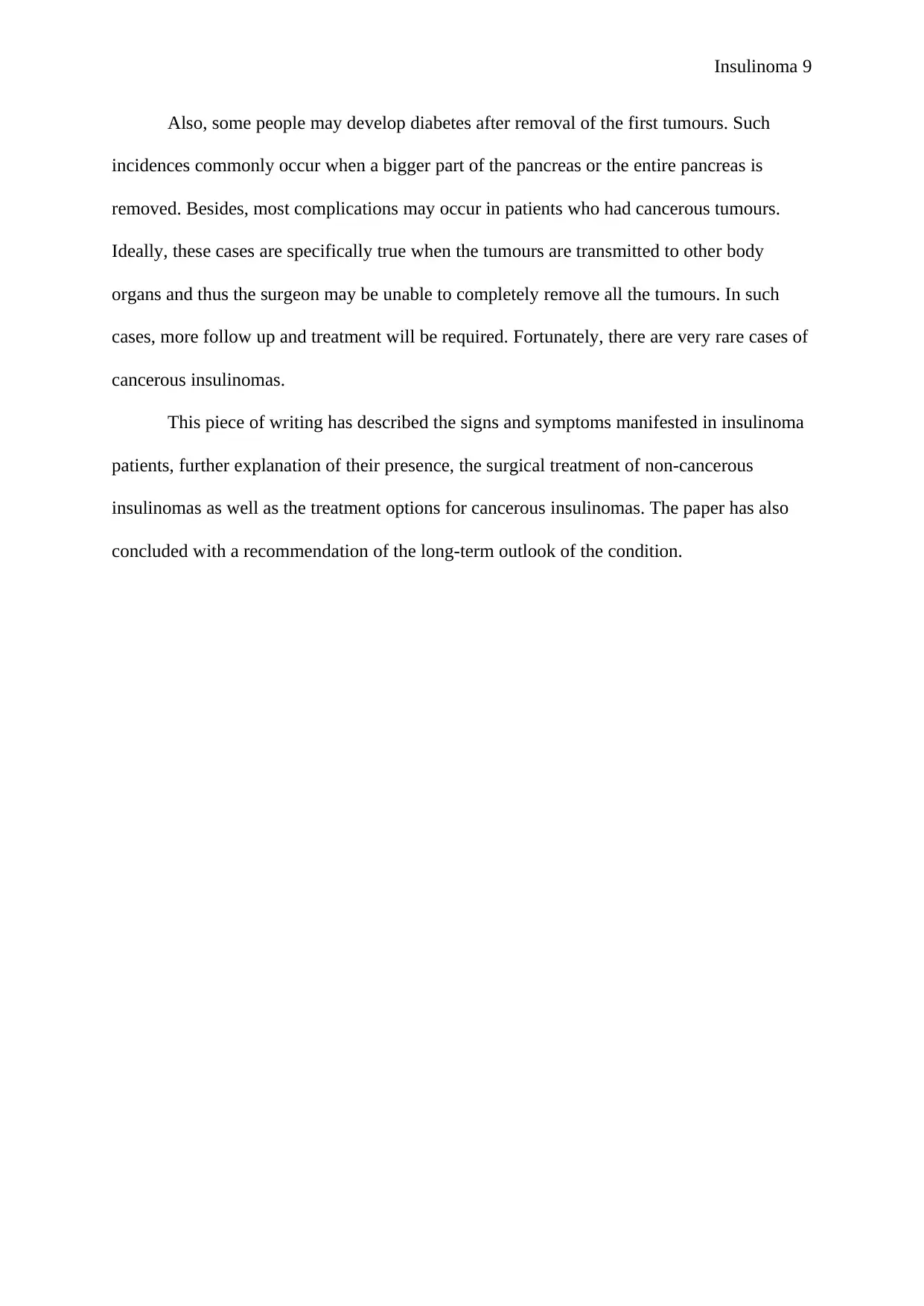
Insulinoma 9
Also, some people may develop diabetes after removal of the first tumours. Such
incidences commonly occur when a bigger part of the pancreas or the entire pancreas is
removed. Besides, most complications may occur in patients who had cancerous tumours.
Ideally, these cases are specifically true when the tumours are transmitted to other body
organs and thus the surgeon may be unable to completely remove all the tumours. In such
cases, more follow up and treatment will be required. Fortunately, there are very rare cases of
cancerous insulinomas.
This piece of writing has described the signs and symptoms manifested in insulinoma
patients, further explanation of their presence, the surgical treatment of non-cancerous
insulinomas as well as the treatment options for cancerous insulinomas. The paper has also
concluded with a recommendation of the long-term outlook of the condition.
Also, some people may develop diabetes after removal of the first tumours. Such
incidences commonly occur when a bigger part of the pancreas or the entire pancreas is
removed. Besides, most complications may occur in patients who had cancerous tumours.
Ideally, these cases are specifically true when the tumours are transmitted to other body
organs and thus the surgeon may be unable to completely remove all the tumours. In such
cases, more follow up and treatment will be required. Fortunately, there are very rare cases of
cancerous insulinomas.
This piece of writing has described the signs and symptoms manifested in insulinoma
patients, further explanation of their presence, the surgical treatment of non-cancerous
insulinomas as well as the treatment options for cancerous insulinomas. The paper has also
concluded with a recommendation of the long-term outlook of the condition.
You're viewing a preview
Unlock full access by subscribing today!

Insulinoma 10
References
Aggeli, C., Nixon, A., Karoumpalis, I., Kaltsas, G. and Zografos, G. 2016. Laparoscopic
surgery for pancreatic insulinomas: an update. HORMONES, 15(2), pp.157-169.
Ali, Z., 2018. Insulinoma: Practice Essentials, Background, Pathophysiology. [online]
Emedicine.medscape.com. Available at:
https://emedicine.medscape.com/article/283039-overview [Accessed 5 Oct. 2018].
Bester, L., Meteling, B., Boshell, D., Chua, T.C. and Morris, D.L., 2014. Transarterial
chemoembolisation and radioembolisation for the treatment of primary liver cancer
and secondary liver cancer: a review of the literature. Journal of medical imaging and
radiation oncology, 58(3), pp.341-352.
Crippa, S., 2018. Surgical Management of Insulinomas. Archives of Surgery, 147(3), p.261.
Faigle, R., Sutter, R. and Kaplan, P.W., 2013. The electroencephalography of encephalopathy
in patients with endocrine and metabolic disorders. Journal of clinical
neurophysiology: official publication of the American Electroencephalographic
Society, 30(5).
Ferrer-Garcia, J.C., Gonzalez-Cruz, V.I., Navas-DeSolis, S., Civera-Andres, M., Morillas-
Arino, C., Merchante-Alfaro, A., Caballero-Díaz, C., Sánchez-Juan, C. and Herrero,
C.C., 2013. Management of malignant insulinoma. Clinical and Translational
Oncology, 15(9), pp.725-731.
Healthline. 2018. Insulinoma: Causes, Symptoms, and Diagnosis. [online] Available at:
https://www.healthline.com/health/insulinoma [Accessed 5 Oct. 2018].
References
Aggeli, C., Nixon, A., Karoumpalis, I., Kaltsas, G. and Zografos, G. 2016. Laparoscopic
surgery for pancreatic insulinomas: an update. HORMONES, 15(2), pp.157-169.
Ali, Z., 2018. Insulinoma: Practice Essentials, Background, Pathophysiology. [online]
Emedicine.medscape.com. Available at:
https://emedicine.medscape.com/article/283039-overview [Accessed 5 Oct. 2018].
Bester, L., Meteling, B., Boshell, D., Chua, T.C. and Morris, D.L., 2014. Transarterial
chemoembolisation and radioembolisation for the treatment of primary liver cancer
and secondary liver cancer: a review of the literature. Journal of medical imaging and
radiation oncology, 58(3), pp.341-352.
Crippa, S., 2018. Surgical Management of Insulinomas. Archives of Surgery, 147(3), p.261.
Faigle, R., Sutter, R. and Kaplan, P.W., 2013. The electroencephalography of encephalopathy
in patients with endocrine and metabolic disorders. Journal of clinical
neurophysiology: official publication of the American Electroencephalographic
Society, 30(5).
Ferrer-Garcia, J.C., Gonzalez-Cruz, V.I., Navas-DeSolis, S., Civera-Andres, M., Morillas-
Arino, C., Merchante-Alfaro, A., Caballero-Díaz, C., Sánchez-Juan, C. and Herrero,
C.C., 2013. Management of malignant insulinoma. Clinical and Translational
Oncology, 15(9), pp.725-731.
Healthline. 2018. Insulinoma: Causes, Symptoms, and Diagnosis. [online] Available at:
https://www.healthline.com/health/insulinoma [Accessed 5 Oct. 2018].
Paraphrase This Document
Need a fresh take? Get an instant paraphrase of this document with our AI Paraphraser
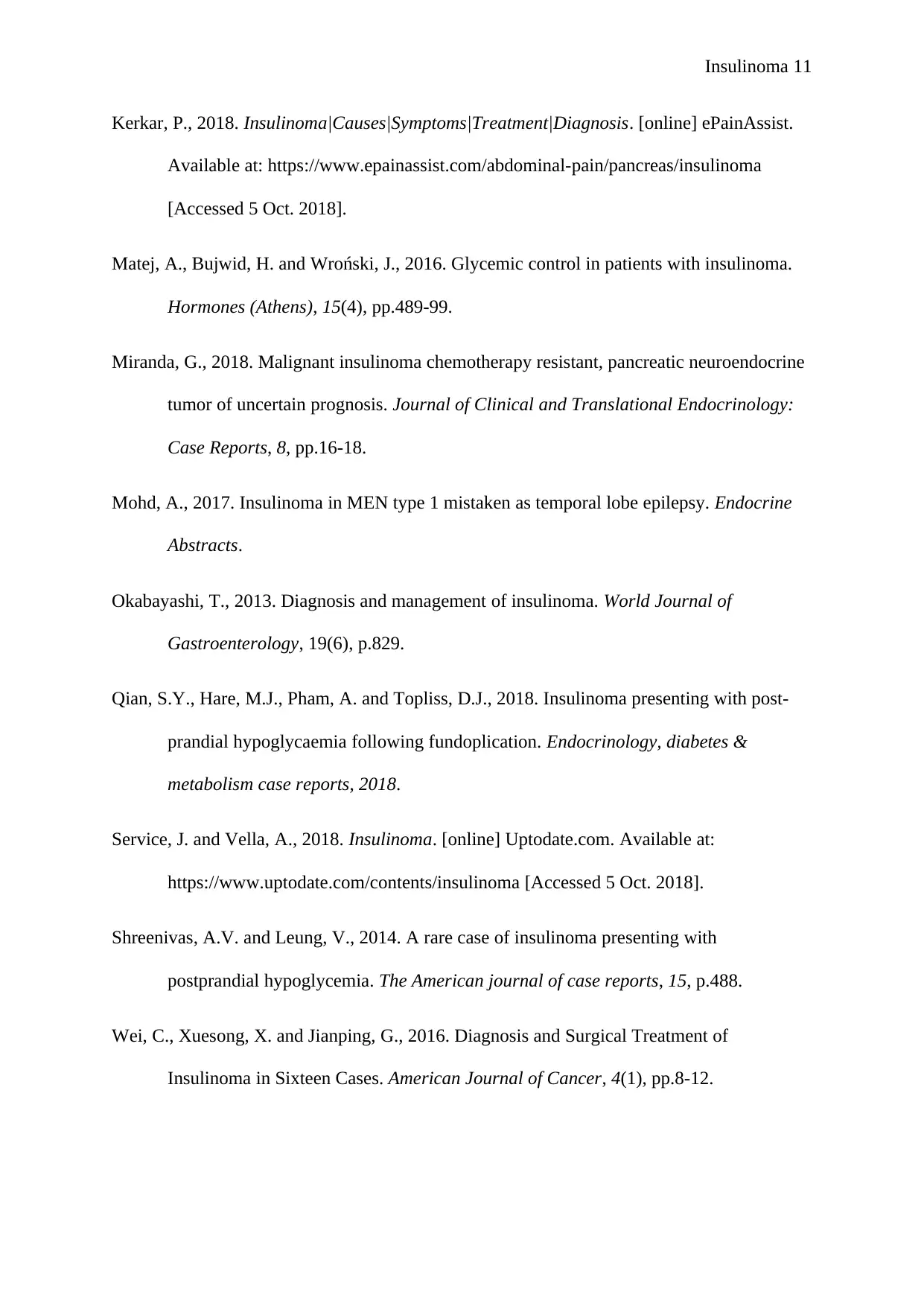
Insulinoma 11
Kerkar, P., 2018. Insulinoma|Causes|Symptoms|Treatment|Diagnosis. [online] ePainAssist.
Available at: https://www.epainassist.com/abdominal-pain/pancreas/insulinoma
[Accessed 5 Oct. 2018].
Matej, A., Bujwid, H. and Wroński, J., 2016. Glycemic control in patients with insulinoma.
Hormones (Athens), 15(4), pp.489-99.
Miranda, G., 2018. Malignant insulinoma chemotherapy resistant, pancreatic neuroendocrine
tumor of uncertain prognosis. Journal of Clinical and Translational Endocrinology:
Case Reports, 8, pp.16-18.
Mohd, A., 2017. Insulinoma in MEN type 1 mistaken as temporal lobe epilepsy. Endocrine
Abstracts.
Okabayashi, T., 2013. Diagnosis and management of insulinoma. World Journal of
Gastroenterology, 19(6), p.829.
Qian, S.Y., Hare, M.J., Pham, A. and Topliss, D.J., 2018. Insulinoma presenting with post-
prandial hypoglycaemia following fundoplication. Endocrinology, diabetes &
metabolism case reports, 2018.
Service, J. and Vella, A., 2018. Insulinoma. [online] Uptodate.com. Available at:
https://www.uptodate.com/contents/insulinoma [Accessed 5 Oct. 2018].
Shreenivas, A.V. and Leung, V., 2014. A rare case of insulinoma presenting with
postprandial hypoglycemia. The American journal of case reports, 15, p.488.
Wei, C., Xuesong, X. and Jianping, G., 2016. Diagnosis and Surgical Treatment of
Insulinoma in Sixteen Cases. American Journal of Cancer, 4(1), pp.8-12.
Kerkar, P., 2018. Insulinoma|Causes|Symptoms|Treatment|Diagnosis. [online] ePainAssist.
Available at: https://www.epainassist.com/abdominal-pain/pancreas/insulinoma
[Accessed 5 Oct. 2018].
Matej, A., Bujwid, H. and Wroński, J., 2016. Glycemic control in patients with insulinoma.
Hormones (Athens), 15(4), pp.489-99.
Miranda, G., 2018. Malignant insulinoma chemotherapy resistant, pancreatic neuroendocrine
tumor of uncertain prognosis. Journal of Clinical and Translational Endocrinology:
Case Reports, 8, pp.16-18.
Mohd, A., 2017. Insulinoma in MEN type 1 mistaken as temporal lobe epilepsy. Endocrine
Abstracts.
Okabayashi, T., 2013. Diagnosis and management of insulinoma. World Journal of
Gastroenterology, 19(6), p.829.
Qian, S.Y., Hare, M.J., Pham, A. and Topliss, D.J., 2018. Insulinoma presenting with post-
prandial hypoglycaemia following fundoplication. Endocrinology, diabetes &
metabolism case reports, 2018.
Service, J. and Vella, A., 2018. Insulinoma. [online] Uptodate.com. Available at:
https://www.uptodate.com/contents/insulinoma [Accessed 5 Oct. 2018].
Shreenivas, A.V. and Leung, V., 2014. A rare case of insulinoma presenting with
postprandial hypoglycemia. The American journal of case reports, 15, p.488.
Wei, C., Xuesong, X. and Jianping, G., 2016. Diagnosis and Surgical Treatment of
Insulinoma in Sixteen Cases. American Journal of Cancer, 4(1), pp.8-12.
1 out of 11
Related Documents
Your All-in-One AI-Powered Toolkit for Academic Success.
+13062052269
info@desklib.com
Available 24*7 on WhatsApp / Email
![[object Object]](/_next/static/media/star-bottom.7253800d.svg)
Unlock your academic potential
© 2024 | Zucol Services PVT LTD | All rights reserved.





